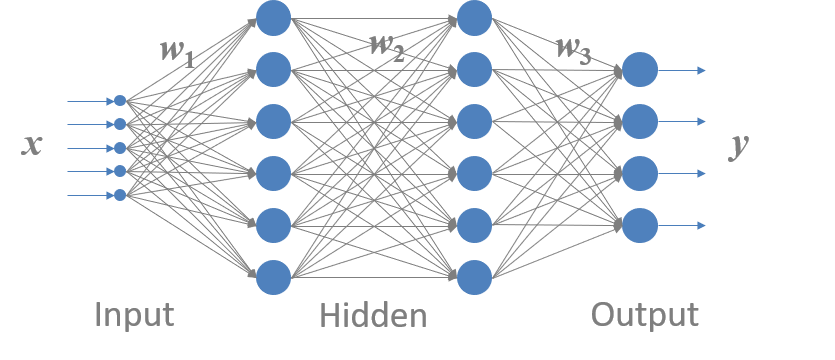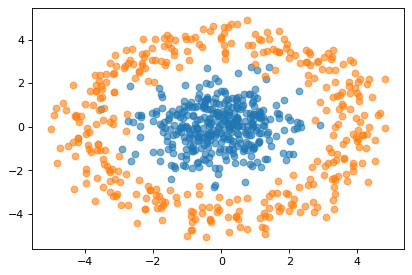PyTorch入门总结4
1 神经网络基本结构
1.1 神经元
神经网络中,神经元模型如下:

用公式表示为:
a
=
σ
(
z
)
=
σ
(
a
1
w
1
+
a
2
w
2
+
⋯
+
a
K
w
K
+
b
)
a = \sigma(z) = \sigma(a_1w_1 + a_2w_2 + \cdots+a_Kw_K + b)
a=σ(z)=σ(a1w1+a2w2+⋯+aKwK+b)
其中,
[
a
1
,
.
.
.
,
a
k
,
.
.
.
,
a
K
]
[a_1, ..., a_k, ...,a_K]
[a1,...,ak,...,aK]为神经元输入,
[
w
1
,
.
.
.
,
w
k
,
.
.
.
w
K
]
[w_1, ..., w_k, ...w_K]
[w1,...,wk,...wK]为每个输入对应的权重,b为偏置,
σ
(
z
)
\sigma(z)
σ(z)为激活函数,
a
a
a为神经元输出。
1.2 神经网络

上图是一个典型的全连接神经网络结构,主要由输入层、隐含层和输出层构成。
其中, x = { x 1 , x 2 , . . . , x k } \boldsymbol x=\{x_1, x_2, ..., x_k\} x={x1,x2,...,xk}为输入特征矢量,是神经网络的输入; y = { y 1 , y 2 , . . . , y d } \boldsymbol y=\{y_1, y_2, ..., y_d\} y={y1,y2,...,yd}为神经网络的输出矢量; Θ = { W , b } \Theta = \{W, b\} Θ={W,b}为神经网络的参数,是神经网络训练过程所训练的对象。
下面以一个二分类问题来距离说明神经网络的基本结构和运行过程:
2 神经网络解决二分类问题
%matplotlib inline
import numpy as np
import matplotlib
import matplotlib.pyplot as plt
import torch
import torch.nn as nn
import torch.nn.functional as F
from torch.utils.data import Dataset, DataLoader
2.1 构造数据集
本文采用的数据集为随机产生的二维高斯分布离散点:
def rotate(theta):
theta = theta * np.pi / 180
r = np.array([np.cos(theta), - np.sin(theta), np.sin(theta), np.cos(theta)]).reshape(2, 2)
return r
x = np.random.multivariate_normal(mean = [0, 0], cov = [[1, 0], [0, 1]], size = 360)
y0 = np.array([4, 0]).reshape(2, 1)
y = np.array([rotate(theta).dot(y0) + np.random.randn(2).reshape(2, 1)/2 for theta in range(360)]).squeeze()
可视化如下:
plt.figure(dpi = 80)
plt.scatter(x[:, 0], x[:, 1], alpha = 0.6)
plt.scatter(y[:, 0], y[:, 1], alpha = 0.6)

构建数据集代码如下:
class dataSet(Dataset):
"""数据集"""
def __init__(self, classA, classB, transform = None):
self.data = torch.tensor(np.vstack((classA, classB)), dtype = torch.float)
self.label = torch.cat((torch.zeros(len(classA), 1), torch.ones(len(classB), 1)))
self.sample = torch.cat((self.data, self.label), 1)
def __len__(self):
return len(self.label)
def __getitem__(self, idx):
return self.sample[idx] # [x, y, label]
Data = dataSet(x, y) # 实例化数据集
dataLoader = DataLoader(Data, batch_size = 4) # 创建数据集迭代器,batch_size = 4
2.2 定义网络结构
对于二分类问题设计了如下简单的全连接神经网络:

定义的网络结构如下:
class LR(nn.Module):
def __init__(self):
super(LR, self).__init__()
self.fc = nn.Linear(2, 5)
self.fc1 = nn.Linear(5, 2)
def forward(self, x):
out = F.elu(self.fc(x))
out = self.fc1(out)
return out
其中,隐藏层fc将输入二维映射为5维(2 → 5),激活函数使用的ELU(指数线性单元);输出层fc1再将隐藏层输出的5维映射为2维,然后利用softmax函数对输出进行归一化,以便于分类。当y[0] > y[1]时,判定为a类,否则判定为b类。(后面会提到,当损失函数为交叉熵时输出层不加softmax函数进行归一化,因为PyTorch的CrossEntropyLoss自带softmax)
2.3 确定其他参数
2.3.1 损失函数
常用的损失函数主要由两个:均方误差和交叉熵。
其中,均方误差为:
MSE
=
1
2
n
∑
i
=
1
n
(
y
i
−
y
i
^
)
2
\text{MSE} = \frac{1}{2n}\sum_{i = 1}^n(y_i-\hat{y_i})^2
MSE=2n1i=1∑n(yi−yi^)2
交叉熵为:
CE
=
−
∑
i
=
1
n
y
i
ln
y
i
^
\text{CE} = -\sum_{i = 1}^ny_i\ln\hat{y_i}
CE=−i=1∑nyilnyi^
对于分类问题来说,往往利用交叉熵作为损失函数,此时神经网络的输出层往往和分类的类别数相同,本例中为C = 2。
由于 { y 1 , y 2 , . . . , y n } \{y_1, y_2, ..., y_n\} {y1,y2,...,yn}中只有一个为1,其它都为0, 因此交叉熵函数可以简化为: CE = − ln y ^ \text{CE} = -\ln \hat{y} CE=−lny^
其中, y ^ \hat{y} y^为模型输出的估计值。当 y ^ \hat{y} y^为1时,损失函数CE = 0;当 y ^ \hat{y} y^趋于0时,损失函数CE趋于无穷大。
此外,PyTorch中的交叉熵损失函数集成了softmax函数,因此在CrossEntropyLoss中的源码可以看到,Pytorch中交叉熵损失函数的计算公式如下:
loss
(
x
,
c
l
a
s
s
)
=
−
ln
(
exp
(
x
[
c
l
a
s
s
]
)
∑
j
exp
(
x
[
j
]
)
)
=
−
x
[
c
l
a
s
s
]
+
ln
(
∑
j
exp
(
x
[
j
]
)
)
\text{loss}(x, class) = -\ln\left(\frac{\exp(x[class])}{\sum_j \exp(x[j])}\right) = -x[class] + \ln\left(\sum_j \exp(x[j])\right)
loss(x,class)=−ln(∑jexp(x[j])exp(x[class]))=−x[class]+ln(j∑exp(x[j]))
其中,
x
x
x为神经网络输出层的输出(不含softmax)),class为样本的标记。如:
>>> output = torch.tensor([1, 2], dtype = torch.float).reshape(1, 2)
>>> label = torch.tensor([1], dtype = torch.long)
>>> criterion = torch.nn.CrossEntropyLoss()
>>> loss = criterion(output, label)
>>> loss
tensor(0.3133)
上述代码中, x = { 1 , 2 } , class = 1 x = \{1, 2\},\text{class} = 1 x={1,2},class=1,代入 loss ( x , l a s s ) \text{loss}(x, lass) loss(x,lass)中可得: loss ( x , c l a s s ) = − ln ( e x [ 1 ] e x [ 0 ] + e x [ 1 ] ) = − ln ( e 2 e 1 + e 2 ) = 0.3133 \text{loss}(x, class) = -\ln(\frac{e^{x[1]}}{e^{x[0]}+e^{x[1]}})=-\ln(\frac{e^2}{e^1+e^2})=0.3133 loss(x,class)=−ln(ex[0]+ex[1]ex[1])=−ln(e1+e2e2)=0.3133
值得注意的是,CrossEntropLoss要求输入的
x
x
x数据类型为torch.float,而
class
\text{class}
class的数据类型为torch.long
2.3.2 优化方法
常用的优化方法有Mini-batch SGD、Adadelta、Adam等,本例对优化方法的要求不高,因此选用Adam方法,它是一种自适应优化方法,基本不需要调参。
optim = torch.optim.Adam(net.parameters())
2.4 训练网络
完成上述操作之后,就可以开始训练神经网络了,如下:
epoches = 100 # 样本迭代次数(训练次数)
net = LR() # 实例化神经网络
optim = torch.optim.Adam(net.parameters()) # 实例化优化器,传入网络net的参数
for i in range(epoches): # 训练
for idx, batch in enumerate(dataLoader): # Mini-batch
data = batch[:, :2] # 前两列为数据
label = batch[:, 2] # 第三列为标签
yhat = net(data) # 正向传播
loss = criterion(yhat, label.long()) # 计算损失
optim.zero_grad() # 清空历史梯度
loss.backward() # 计算当前梯度
optim.step() # 更新参数
if i % 10 == 0:
print(loss) # 打印当前损失
输出:
tensor(0.4932, grad_fn=<NllLossBackward>)
tensor(0.0518, grad_fn=<NllLossBackward>)
tensor(0.0202, grad_fn=<NllLossBackward>)
tensor(0.0123, grad_fn=<NllLossBackward>)
tensor(0.0071, grad_fn=<NllLossBackward>)
tensor(0.0046, grad_fn=<NllLossBackward>)
tensor(0.0033, grad_fn=<NllLossBackward>)
tensor(0.0025, grad_fn=<NllLossBackward>)
tensor(0.0019, grad_fn=<NllLossBackward>)
tensor(0.0015, grad_fn=<NllLossBackward>)
可以看到,损失函数下降很快,当训练不到50次时,损失函数已经达到0.01以下。
2.5 可视化训练结果
利用matplotlib绘制出分类面如下:

可以看出,该网络很好的对两类数据进行了分类,在另一个同分布的测试样本集上的分类效果如下图所示:

可视化部分代码如下:
def visualization(net, x, y):
x = np.linspace(-5, 5, 1000)
y = np.linspace(-5, 5, 1000)
X, Y = torch.tensor(np.meshgrid(a, b))
point = torch.cat((X.unsqueeze(dim = 2), Y.unsqueeze(dim = 2)), dim = 2).reshape(-1, 2).float()
out = net(point)
val = (out[:, 1] > out[:, 0]) .reshape(1000, 1000)
plt.figure(dip = 80)
plt.scatter(x[:, 0], x[:, 1], alpha = 0.6)
plt.scatter(y[:, 0], y[:, 1], alpha = 0.6)
plt.contour(np.array(X), np.array(Y), val, colors = 'r' , alpha = 0.3)
























 1403
1403

 被折叠的 条评论
为什么被折叠?
被折叠的 条评论
为什么被折叠?








